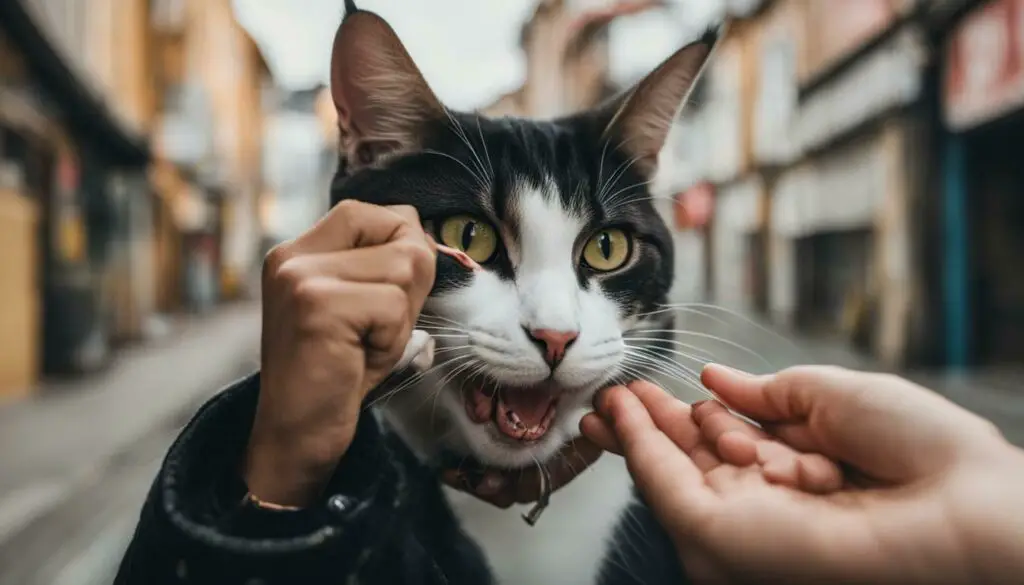Cat bites can be a concerning behavior, and it’s crucial to understand why they occur and how to effectively address them. It’s important to recognize the potential dangers of cat bites, as they can lead to infections. Seeking medical attention if bitten is essential to ensure proper treatment and prevent complications.
There are several reasons why cats may bite, and understanding these reasons is key to addressing the behavior. Cats may bite as a way to communicate, signaling that they’ve reached their tolerance for petting or handling. Play aggression is also common in kittens, but it’s important to redirect this behavior to appropriate toys and discourage biting. Additionally, fear or stress can trigger cat bites, and creating a safe and calm environment for the cat is crucial to reduce aggression.
It’s important to rule out any underlying medical issues that may contribute to aggression in cats. Certain health problems can cause pain or discomfort, leading to defensive behavior. Consulting with a veterinarian and conducting necessary tests can help identify and address these issues.
Recognizing the signs of aggression in cats is essential in preventing bites and ensuring a safe environment. Understanding their body language and vocalizations can serve as warning signs, allowing owners to take appropriate measures to prevent attacks and respond accordingly. By observing their behavior closely, cat owners can better understand their cats and intervene before a bite occurs.
Key Takeaways:
- Seek medical attention if bitten by a cat, as bites can lead to infections.
- Cats may bite to communicate their discomfort or as a result of play aggression or fear.
- Create a safe and calm environment to reduce stress and prevent cat bites.
- Ruling out underlying medical problems is crucial in addressing aggression in cats.
- Recognize the signs of aggression in cats to prevent attacks and respond appropriately.
Why Do Cats Bite?
Cats may bite their owners’ faces for various reasons, including communication, play aggression, fear, and stress. Understanding why cats engage in this behavior is crucial in addressing and preventing it.
Communication is a common reason for cats to bite. They may feel overstimulated during petting sessions and use biting as a way to signal that they’ve had enough. Pay attention to your cat’s body language and vocalizations, such as flattened ears, tail flicking, or growling, as warning signs that they may become agitated.
Play aggression is another reason why cats may bite. Kittens, in particular, have a natural instinct to play and explore their surroundings using their teeth and claws. However, it’s essential to redirect this behavior to appropriate toys to avoid injuries. Offer interactive toys and engage in play sessions to provide an outlet for their energy.
Fear and stress can also trigger cat bites. Cats may feel threatened or anxious in certain situations, causing them to lash out defensively. Create a safe and calm environment for your cat, providing hiding spots and vertical spaces where they can retreat to when feeling overwhelmed. It’s essential to gradually expose your cat to new experiences and people to desensitize them to potential stressors.
Lastly, medical issues can sometimes cause aggression in cats. If you notice a sudden change in your cat’s behavior, including increased aggression or biting, it’s crucial to rule out any underlying health problems. Consult with a veterinarian to conduct a thorough examination and appropriate diagnostic tests.

Table 1: Common Causes of Cat Bites
| Cause | Description |
|---|---|
| Communication | Cats may bite to indicate they’ve had enough petting or to express discomfort. |
| Play Aggression | Kittens may bite during play, but redirecting their attention to appropriate toys is important. |
| Fear and Stress | Cats may bite defensively when they feel threatened or anxious in certain situations. |
| Medical Issues | Underlying health problems can sometimes cause aggression in cats, necessitating veterinary attention. |
By understanding the reasons behind cat bites, you can take appropriate measures to prevent and address this behavior. Recognize the warning signs, create a safe environment, provide appropriate outlets for play, and seek veterinary help when necessary. Remember that addressing cat bites requires patience, consistency, and a commitment to the well-being of both you and your feline companion.
Recognizing Aggression in Cats
Recognizing the signs of aggression in cats is crucial to prevent cat bites. It’s important to understand their body language and vocalizations as warning signs before a bite occurs. Cats often exhibit specific behaviors when they’re feeling threatened or stressed. Some common signs of aggression include:
- Growling or hissing
- Ears flattened against the head
- Purring with a tense body posture
- Tail flicking or lashing aggressively
- Dilated pupils
These signs serve as an indication that the cat may bite if the current situation escalates. It’s crucial to respond appropriately to prevent cat bites and keep both yourself and the cat safe. When you notice any of these signs, it’s essential to give the cat space and avoid any sudden movements or attempts to handle or pet them.
In addition to body language, vocalizations can also provide valuable insights into a cat’s aggressive state. Growling, hissing, and yowling are typical vocal warning signs exhibited by aggressive cats. Understanding and recognizing these vocal cues can help you gauge the level of aggression and respond accordingly.
Aggressive Cat Body Language:
| Aggressive Behavior | Body Language |
|---|---|
| Growling or hissing | Ears flattened against the head |
| Purring with a tense body posture | Tail flicking or lashing aggressively |
| Dilated pupils |
By paying close attention to these behavioral cues, you can identify the warning signs of aggression in cats and take appropriate action to prevent cat bites. Remember, understanding the cat’s emotions and responding calmly and respectfully is key to maintaining a safe and harmonious relationship with your feline friend.
Creating a Safe Environment
Creating a safe environment is key in reducing the likelihood of cat bites. Cats rely on their surroundings to feel secure and comfortable, and a stressful environment can lead to aggression. Providing hiding spots, vertical spaces, and enriching activities can help alleviate stress and promote a calmer atmosphere. Cats need places where they can retreat to when they feel overwhelmed or anxious, so providing cozy hiding spots, such as cardboard boxes or covered beds, can be beneficial. Vertical spaces, like cat trees or shelves, allow cats to climb and observe their surroundings, which can help them feel more in control and less threatened. Additionally, engaging your cat in enriching activities, such as interactive toys or puzzle feeders, can keep them mentally stimulated and divert their attention away from potential triggers for aggression.
Furthermore, proper socialization is crucial in creating a safe environment for cats. Introducing them gradually to new people and animals helps them feel more comfortable and reduces the chances of defensive or aggressive behavior. Positive experiences during socialization, such as rewarding calm and friendly interactions, can reinforce positive behaviors and build trust. Along with socialization, it’s important to establish boundaries and teach children, as well as adults, how to interact with cats safely and respectfully. By teaching gentle petting techniques and emphasizing the importance of not pulling tails or ears, we can prevent unintentional triggers for cat bites.
Table: Tips for creating a safe environment
| Tips | Description |
|---|---|
| Provide hiding spots | Offer cozy hiding spots, such as cardboard boxes or covered beds, where your cat can retreat when feeling stressed or overwhelmed. |
| Create vertical spaces | Set up cat trees or shelves to provide your cat with vertical spaces where they can feel secure and observe their surroundings. |
| Engage in enriching activities | Keep your cat mentally stimulated by providing interactive toys and puzzle feeders that redirect their attention and energy. |
| Socialize your cat | Gradually introduce your cat to new people and animals, rewarding positive interactions and ensuring a sense of safety. |
| Teach safe interactions | Educate both children and adults on how to interact with cats respectfully, emphasizing gentle petting and not pulling tails or ears. |
By creating a safe environment and promoting positive interactions, we can greatly reduce the chances of cat bites. However, it’s important to remember that each cat is unique, and what works for one may not work for another. If you’re experiencing frequent or severe aggression in your cat, it’s always recommended to seek professional advice from a behaviorist or trainer who can provide specialized guidance tailored to your cat’s specific needs.

Redirecting Aggressive Behavior
Redirecting aggressive behavior in cats is essential to prevent face biting incidents. By understanding the underlying causes of aggression and implementing appropriate strategies, we can help create a safer and more harmonious environment for both cats and their owners.
One effective method of redirecting aggression is through interactive play sessions. Engaging cats in play with toys, such as feather wands or interactive puzzles, can help channel their energy and provide an outlet for their hunting instincts. By redirecting their focus onto these toys, we can redirect their aggression away from face biting.
Creating a stimulating environment with scratching posts and other enrichment activities is also crucial in preventing aggression. Providing cats with alternative outlets for their natural behaviors, such as climbing, scratching, and exploring, can help alleviate stress and reduce the likelihood of aggressive episodes.
Additionally, positive reinforcement techniques can be used to reinforce desirable behavior and discourage aggression. Rewarding cats with treats or praise for calm and non-aggressive behavior can help them associate positive experiences with appropriate interactions. Consistency and patience are key when using positive reinforcement.
| Redirecting Aggressive Behavior | Benefits |
|---|---|
| Interactive play sessions with toys | Channels energy and redirects aggression |
| Providing stimulating environment | Reduces stress and prevents aggressive episodes |
| Positive reinforcement techniques | Reinforces desirable behavior and discourages aggression |

“Redirecting aggressive behavior in cats is crucial to prevent face biting incidents. By engaging them in interactive play, creating a stimulating environment, and using positive reinforcement, we can help redirect their aggression and promote a safer and happier coexistence.”
Summary:
In summary, redirecting aggressive behavior in cats is essential to prevent face biting incidents. By engaging cats in interactive play sessions, providing a stimulating environment, and using positive reinforcement techniques, we can redirect their aggression and promote a safer and happier coexistence. It’s important to understand the underlying causes of aggression and seek professional help if needed. With patience, consistency, and a proactive approach, we can create a harmonious environment for both cats and their owners.
Seeking Veterinary Help
If bitten by a cat, it’s crucial to seek veterinary help to prevent complications and ensure proper treatment. Cat bites can be more serious than they initially appear, as they have the potential to cause infections. Veterinary attention is necessary to assess the severity of the bite and determine the appropriate course of action.
Cat bites have a high risk of infection due to the bacteria present in a cat’s mouth. Seeking veterinary help promptly can minimize the chances of infection and prevent further complications. Your veterinarian will thoroughly clean the wound and may prescribe antibiotics if necessary.
In some cases, medical treatment may also be required to manage any underlying medical issues that may be contributing to the aggressive behavior. A thorough examination and diagnostic tests can help identify and address any potential health concerns that may be causing or exacerbating the cat’s aggression.
| Key Points: |
|---|
| • Seek veterinary help if bitten by a cat to prevent infection and ensure proper treatment. |
| • Cat bites have a high risk of infection due to bacteria in their mouths. |
| • Cleaning the wound and administering antibiotics may be necessary. |
| • Medical examination and testing may be needed to address underlying health issues. |
Training and Behavior Modification
Training and behavior modification can play a crucial role in preventing cat bites. By understanding the reasons behind a cat’s aggression, we can implement effective strategies to redirect their behavior and promote positive interactions. Positive reinforcement training methods, such as rewarding desired behaviors with treats or praise, can help shape their behavior and create a stronger bond between cats and their owners.
One important aspect of training is teaching cats appropriate play behaviors. Using interactive toys and play sessions can help channel their energy and engage in more appropriate play, reducing the likelihood of biting. Providing scratching posts and other enrichment activities can also help satisfy their natural instincts and prevent boredom, which can lead to aggressive behaviors.
When implementing behavior modification techniques, consistency is key. Cats thrive on routines and predictability, so establishing clear boundaries and expectations can help prevent cat bites. It’s also important to be patient and understanding, as addressing aggression may take time and effort.
| Training and Behavior Modification | Key Points |
|---|---|
| Positive Reinforcement | Use treats or praise to reward desired behaviors and encourage positive interactions. |
| Appropriate Play | Engage cats in interactive play sessions and provide toys to redirect their energy. |
| Environmental Enrichment | Offer scratching posts and other enrichment activities to satisfy natural instincts and prevent boredom. |
| Consistency and Patience | Establish clear boundaries and expectations, and be patient throughout the behavior modification process. |
Seeking professional help from behaviorists or trainers may also be beneficial, especially in more complex cases of aggression. These professionals can provide personalized behavior modification plans and offer guidance tailored to the specific needs of cats and their owners. Their expertise and experience can make a significant difference in addressing cat bites and promoting a safe and harmonious relationship.
Remember, prevention is key. By proactively addressing the underlying causes of aggression and employing effective training and behavior modification techniques, we can create a safe and loving environment for our cats, reducing the risk of cat bites and fostering a strong bond based on trust and understanding.
Handling Aggressive Episodes
Handling aggressive episodes in cats requires a calm and measured approach. When faced with an aggressive cat, it’s important not to punish or escalate the situation. Instead, try to redirect their attention to toys or treats that can help distract them from their aggression. Giving the cat some space and time to calm down is also crucial.
It’s essential to remember that aggression in cats can have various underlying causes, such as fear, stress, or even medical issues. Observing and understanding the warning signs can help prevent aggressive episodes from escalating into bites. Signs of aggression may include dilated pupils, hissing, growling, raised fur, and ears pinned back.
Creating a safe environment for your cat is vital in reducing aggressive behavior. Provide hiding spots and vertical spaces for them to retreat to when they feel overwhelmed. Additionally, engage your cat in interactive play sessions using toys designed to simulate hunting behavior. Puzzle feeders can also be used to stimulate their mind and redirect their energy.
| Warning Signs of Cat Aggression |
|---|
| Dilated pupils |
| Hissing and growling |
| Raised fur |
| Pinned-back ears |
If your cat’s aggressive behavior persists or escalates, it’s important to seek professional help from a behaviorist or trainer experienced in working with aggressive cats. They can develop a personalized behavior modification plan that addresses the underlying causes of aggression and helps you establish a safer and more harmonious relationship with your cat.
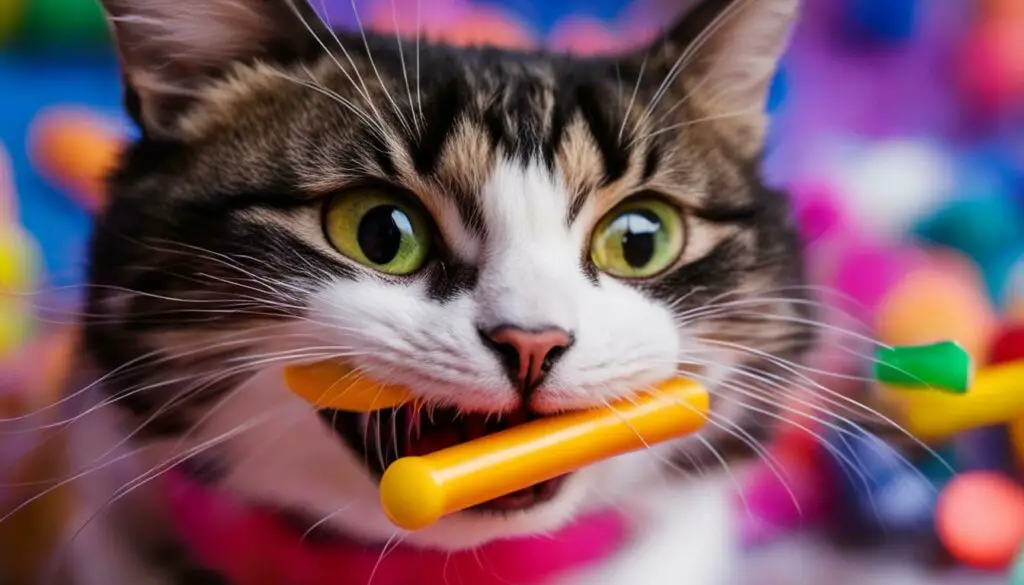
Remember, handling aggressive episodes in cats requires patience and understanding. By providing a safe environment, recognizing warning signs, and seeking professional help if needed, you can effectively manage and prevent cat bites.
Addressing Medical Causes
Medical causes should be considered when addressing cat bites. Sometimes, underlying health issues can contribute to a cat’s aggressive behavior. If a cat suddenly starts biting, it’s important to rule out any medical conditions that may be causing discomfort or pain. For example, dental problems, infections, or neurological issues can all potentially trigger aggression in cats.
Observing the cat for other symptoms or changes in behavior can help identify possible medical causes. If the cat is showing signs of illness, such as lethargy, loss of appetite, or changes in litter box habits, it’s crucial to seek veterinary guidance. The vet may perform a thorough examination, conduct necessary tests, and provide appropriate treatment to address the underlying medical issue.
In some cases, behavioral issues may overlap with medical causes, making it essential to consult with a professional veterinarian or veterinary behaviorist. They can assess the cat’s overall health, behavior, and environment to develop a comprehensive treatment plan that addresses both the medical and behavioral aspects.
Socializing Cats Properly
Proper socialization plays a crucial role in preventing cat bites. Taking the time to socialize your cat from a young age can help them develop positive behaviors and reactions to different situations. By exposing them to a variety of people, animals, and environments in a controlled and positive manner, you can help them feel more comfortable and confident in different social settings.
One important aspect of socializing cats is gradually introducing them to new people and animals. It’s essential to provide a calm and safe environment for these introductions, allowing your cat to approach at their own pace. Using positive reinforcement, such as treats and praise, can help create positive associations and reduce fear or anxiety.
| Socialization Tips |
|---|
| Start early: Begin socializing your cat during their critical socialization period, usually between 2-7 weeks old. |
| Positive experiences: Encourage positive interactions with new people and animals by providing treats and praise. |
| Gradual introductions: Introduce your cat to new environments, sounds, and experiences slowly and in a controlled manner. |
| Utilize playtime: Incorporate play sessions as a way to bond with your cat and provide mental stimulation. |
| Be patient: Each cat is unique and may require different amounts of time to become comfortable in new situations. |
Remember that socialization is an ongoing process, and it’s important to continue exposing your cat to new experiences throughout their life. By socializing your cat properly, you can help prevent cat bites and create a well-adjusted and happy feline companion.
The Role of Environmental Enrichment
Environmental enrichment is essential in preventing cat bites by keeping cats mentally and physically engaged. Providing a stimulating environment helps alleviate boredom and reduces frustration, which can contribute to aggressive behavior. By offering various enrichment opportunities, we can redirect their energy and satisfy their natural instincts.
One way to enrich a cat’s environment is by offering a variety of toys that encourage physical activity and mental stimulation. Interactive toys, such as puzzle feeders or treat-dispensing toys, engage their hunting instincts while providing a rewarding challenge. Additionally, toys that mimic prey, like feather wands or laser pointers, allow cats to engage in play and release excess energy.
Creating vertical spaces is also crucial for environmental enrichment. Cats enjoy climbing and observing their surroundings from high vantage points. Providing cat trees, shelves, or window perches allows them to fulfill their natural desire to climb and explore. These vertical spaces not only provide physical exercise but also help reduce stress by offering a sense of security and control over their environment.
| Enrichment Ideas | Benefits |
|---|---|
| Scatter feeding | Stimulates natural foraging behaviors and adds mental challenge |
| Hiding spots and cozy beds | Provide a sense of security and privacy |
| Cardboard boxes and paper bags | Offer opportunities for exploration and play |
| Sound and motion-activated toys | Engage a cat’s hunting instincts and provide hours of entertainment |
In addition to physical and mental stimulation, it’s essential to create a peaceful and stress-free environment for your cat. Minimizing loud noises, providing hiding spots, and offering a routine that includes predictable feeding and play times can help reduce anxiety and prevent aggressive behavior. Ensuring they have a designated space where they can retreat and relax is also crucial.
Remember, every cat is unique, and it may take some trial and error to find the right enrichment activities that resonate with your furry companion. By providing a well-rounded and enriching environment, you can significantly reduce the likelihood of cat bites and promote a harmonious relationship between you and your feline friend.
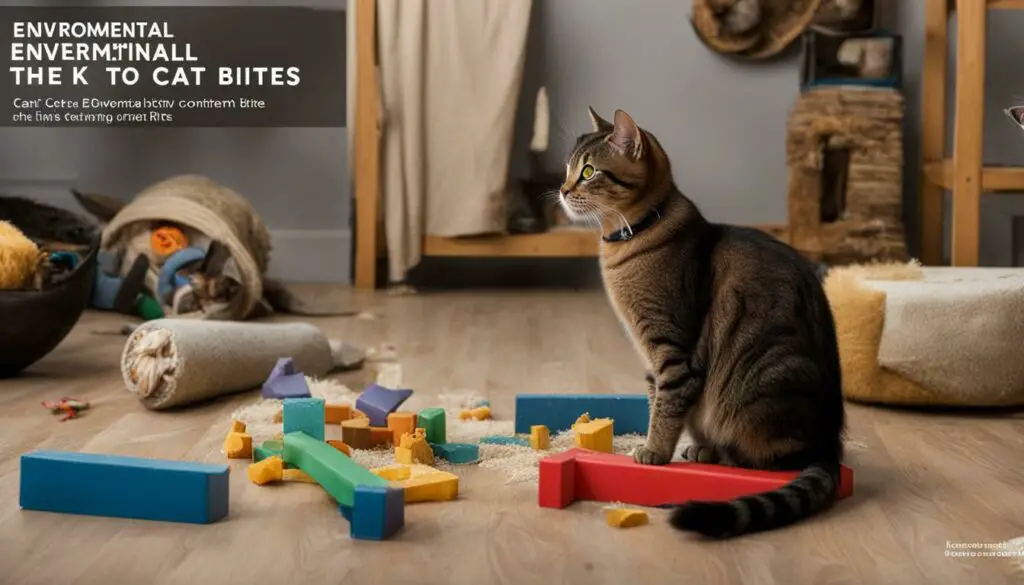
Implementing Positive Reinforcement
There are a lot of different behaviors that you might want to encourage your cat to do. Whether it’s using the liter box, not scratching the furniture, or coming when called, you can usually achieve your goals by using positive reinforcement. This is a training method that rewards your cat for desired behaviors. The most common form of positive reinforcement is giving your cat a treat, but you can also use petting, verbal praise, or toys.
To get started, you’ll need to identify the behaviors you want to encourage. Once you’ve done that, you can begin to implement a positive reinforcement program. Here are some tips:
• Start with small steps. If you’re trying to teach your cat to use the liter box, for example, begin by placing her in the box after she wakes up from a nap or after she eats. As she becomes more comfortable with using the box, you can gradually increase the time she spends in it.
• Be consistent. It’s important to reward your cat every time she exhibits the desired behavior. If you only give her a treat sometimes, she’ll become confused and won’t know which behaviors are being rewarded.
• Be patient. Learning takes time, so don’t expect your cat to master a new behavior overnight. Have patience and continue to praise her when she does something right.
• Make it fun. Training should be a positive experience for both you and your cat. If she seems stressed or uninterested, take a break and try again later.
Here are some general guidelines for using positive reinforcement:
• Choose a cue or signal that you’ll use to let your cat know when she’s done something right. This could be a clicker sound, a verbal cue like “good girl,” or simply giving her a treat.
• Decide what reinforcer you’ll use. This is usually a treat, but it could also be petting, verbal praise, or a toy.
• Begin by rewarding your cat for any desired behavior, no matter how small. For example, if you’re trying to train her to use the liter box, reward her every time she goes near it.
• Once she’s consistently performing the desired behavior, you can start to phase out the rewards. This means rewarding her less often for the same behavior. For example, if she’s using the liter box regularly, you might only give her a treat every other time she uses it.
• eventually, you should be able to stop rewarding her altogether. At this point, the behavior has become ingrained and she’ll continue to do it even without a reward.
Positive reinforcement is a powerful training tool, but it’s important to use it correctly. These tips should help you get started on the right foot.
Positive reinforcement is a valuable tool in preventing cat bites. By rewarding desired behaviors and using treats or praise, we can reinforce positive interactions with our feline companions. Cats respond well to positive reinforcement, as it helps create a positive association and encourages them to repeat the desired behavior.
When it comes to preventing cat bites, one effective technique is to reward calm and gentle behavior. For example, if your cat approaches you without showing signs of aggression, gently pet them and offer a small treat. This reinforces the idea that approaching you calmly leads to positive interactions.
Another way to utilize positive reinforcement is to redirect your cat’s aggressive behavior towards appropriate toys or scratching posts. When you notice your cat becoming tense or displaying aggressive body language, quickly provide them with a toy they enjoy or redirect their attention to a scratching post. By doing so, you are teaching your cat that these are the appropriate outlets for their energy and natural behaviors.
Creating a Positive Environment
In addition to positive reinforcement, creating a positive environment plays a crucial role in preventing cat bites. Cats thrive in environments that provide them with mental and physical stimulation.
Consider providing interactive toys, puzzle feeders, and scratching posts to keep your cat engaged. These activities help satisfy their natural instincts and redirect any pent-up energy. Additionally, designate safe spaces or hiding spots where your cat can retreat when they feel overwhelmed or stressed. This allows them to have a sense of control and contributes to a calmer overall atmosphere.
Remember, consistency and patience are key when implementing positive reinforcement techniques and creating a positive environment. By focusing on rewarding positive behaviors and providing an enriching space for your cat, you can effectively prevent cat bites and establish a harmonious bond with your feline companion.
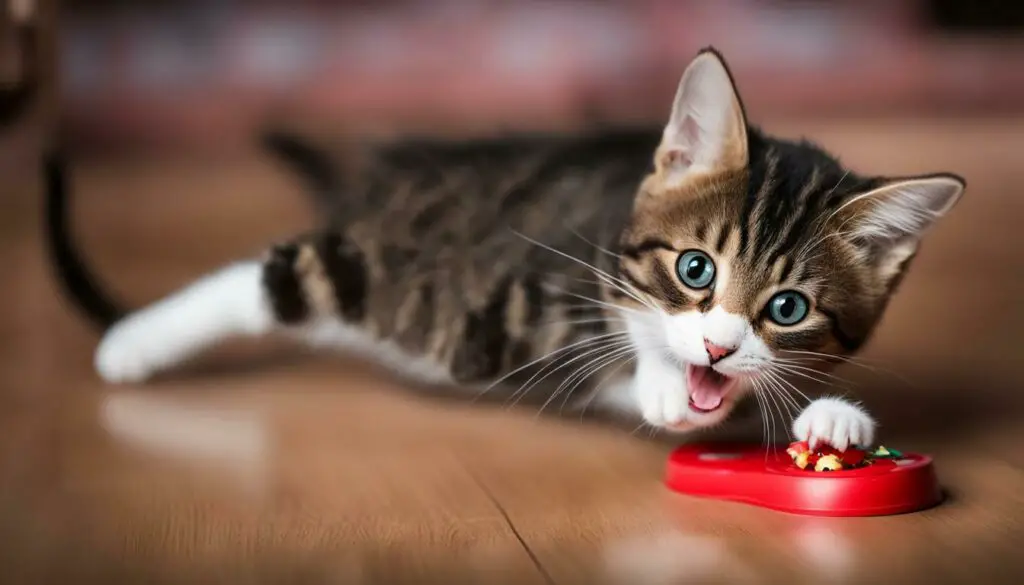
Seeking Professional Help for Cat Bite Prevention and Safety
If you have a cat, it’s important to be aware of the risks of being bitten. Cat bites can cause serious infection, so it’s important to take precautions to prevent them. Here are some tips for preventing cat bites and what to do if you’re bitten:
• Keep your cat’s nails trimmed. Long nails can puncture skin and increase the risk of infection.
• Don’t play rough with your cat. Avoid games that involve striking or wrestling, as this can provoke biting.
• Be aware of your cat’s body language. If your cat is hissing, growling, or showing its claws, it may be about to bite.
• If you’re bitten, wash the wound immediately with soap and water. Apply pressure to stop the bleeding, and see a doctor if the wound is deep or if you have any concerns about infection.
Cat bites can be serious, so it’s important to take precautions to prevent them. If you’re bitten, seek medical attention immediately.
Seeking professional help can be beneficial in addressing cat bites, especially in more complex cases. Professional behaviorists or trainers have the expertise and experience to develop personalized behavior modification plans tailored to your cat’s specific needs. They can provide guidance on understanding the underlying reasons behind cat bites and offer effective strategies to prevent and redirect aggressive behavior.
Professional help is particularly important when dealing with cat bites that involve severe aggression or recurring incidents. Behaviorists or trainers can assess the situation and provide expert advice on how to manage and modify the behavior. They can teach you effective techniques for handling aggressive episodes, such as using distraction techniques or providing appropriate outlets for your cat’s energy.
In addition to addressing the immediate issue of cat bites, professional help can also assist in identifying any underlying medical causes contributing to the aggression. They can work alongside veterinarians to rule out any health issues that may be triggering the behavior. By taking a holistic approach, professionals can help ensure the well-being and safety of both you and your cat.
| Benefits of Seeking Professional Help for Cat Bite Prevention and Safety |
|---|
| Expert guidance: Behaviorists or trainers have specialized knowledge on cat behavior and can provide professional guidance to address cat bites effectively. |
| Personalized plans: Professionals can develop personalized behavior modification plans tailored to your cat’s specific needs, taking into account their unique personality and triggers. |
| Assessment and diagnosis: Professionals can assess the situation and help identify any underlying medical causes or environmental factors contributing to the aggressive behavior. |
| Training techniques: They can teach you effective strategies for managing and redirecting aggression, ensuring the safety of both you and your cat. |

No matter the severity or frequency of cat bites, seeking professional help is a proactive step towards preventive measures and a safer environment for everyone involved. Remember to choose qualified and reputable professionals who prioritize positive reinforcement and follow ethical training practices. By working together with a professional, you can gain valuable insights and skills to address cat bites and foster a harmonious relationship with your feline companion.
Education and Awareness
Education and awareness about cat behavior are key in preventing cat bites. Understanding why cats bite and how to address their behavior is crucial for creating a safe and harmonious environment for both humans and feline companions. By being knowledgeable about the potential dangers of cat bites, such as infections, and knowing how to respond appropriately, we can minimize the risk of harm.
One way to educate ourselves and others is by seeking reliable resources such as books, online articles, and local workshops that provide information on cat behavior and bite prevention. These resources often offer valuable insights into understanding the reasons behind cat bites, recognizing warning signs, and implementing effective strategies to prevent and redirect aggressive behavior.
Additionally, sharing knowledge and promoting awareness within our communities can make a significant impact in preventing cat bites. By educating friends, family members, and even children on how to interact safely and respectfully with cats, we can reduce the likelihood of bites and create a more harmonious relationship between humans and feline companions.
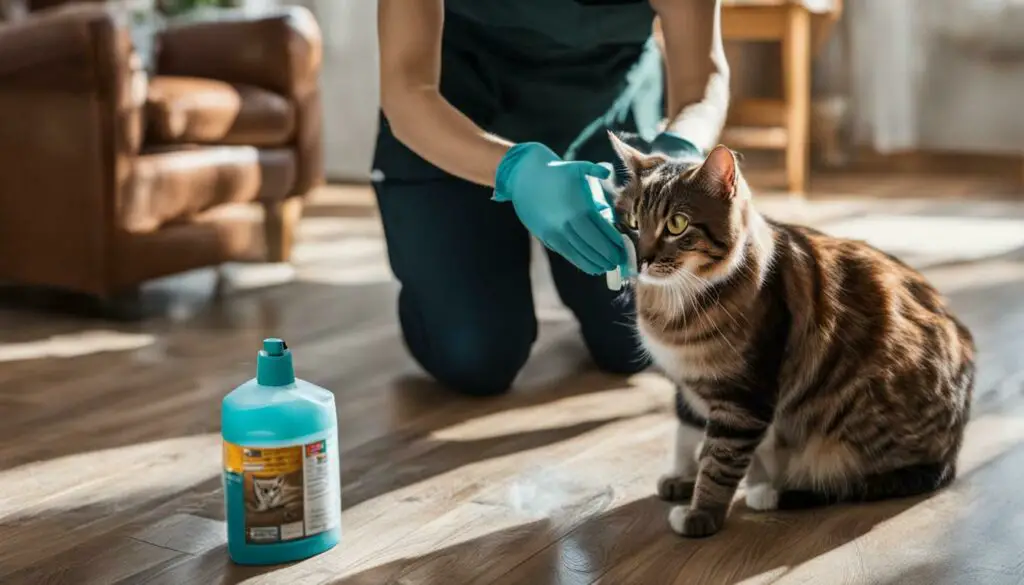
In conclusion, education and awareness play a crucial role in preventing cat bites. By understanding the reasons behind cat bites, recognizing the warning signs, and implementing appropriate strategies, we can create a safer and more enjoyable environment for ourselves and our furry friends.
Encouraging Responsible Ownership
Responsible ownership is crucial in preventing cat bites and ensuring the well-being of our feline companions. By understanding the needs and behaviors of cats, we can create a safe and harmonious environment that reduces the risk of aggression. Here are some key aspects to consider when it comes to responsible ownership:
- Veterinary Care: Regular veterinary check-ups and vaccinations are essential to keep cats healthy and prevent any underlying medical issues that may contribute to aggression.
- Spaying/Neutering: This not only helps control the cat population but also reduces territorial and aggressive behaviors in cats.
- Exercise and Enrichment: Providing ample opportunities for exercise and mental stimulation helps cats release energy in a positive way, reducing the likelihood of boredom-related aggression.
- Teaching Children: Educate children on how to interact with cats safely and gently. Encourage them to respect the cat’s boundaries and avoid rough play.
Creating a Safe Home Environment
As a pet owner, you are responsible for the safety of your animal and those around it. Here are some tips on how to create a safe home environment for your cat:
• Avoid potential hazards. Be aware of items in your home that may pose a threat to your cat, such as poisonous plants, small objects that could be swallowed, and electrical cords.
• Provide a safe place for your cat to retreat. When guests come over or there is commotion in the home, provide a quiet space for your cat to hide away.
• Keep your cat up-to-date on vaccinations. This will help protect them from illnesses that could be harmful or even deadly.
• Spay or neuter your cat. This will help reduce aggression and the risk of biting.
• Handle your cat gently and calmly. Avoid roughhousing or handling them in a way that may startle or scare them.
• Be aware of your cat’s body language. If they seem agitated or uncomfortable, give them some space.
If you have young children in the home, it’s important to take extra precautions to ensure their safety around the cat.
• Teach children to be gentle with animals. They should know how to pet and hold them properly.
• Never leave a child unsupervised with a pet. Accidents can happen quickly, and children may not understand how to react or get help if something goes wrong.
• Keep an eye on interactions between children and pets. If you see signs of aggression from either the child or the animal, intervene and separate them.
If your cat does bite someone, it’s important to take proper care of the wound and monitor for any signs of infection.
• Clean the wound with warm water and soap. Apply pressure to stop any bleeding.
• See a doctor if the wound is deep or bleeding does not stop. Infections from cat bites can be serious, so it’s important to seek medical attention if there is any concern.
• Watch for signs of infection, such as redness, swelling, or discharge from the wound. If you notice any of these, make an appointment with your doctor.
By following these tips, you can help create a safe and enjoyable home environment for both you and your cat.
Our homes should be a sanctuary for our cats. Here are some tips on how to create a safe and stress-free environment:
- Hiding Spots: Ensure that your cat has hiding spots where they can retreat when they feel overwhelmed or anxious.
- Vertical Spaces: Provide tall cat trees or shelves that allow your cat to climb and observe their surroundings, promoting a sense of security.
- Enriching Activities: Engage your cat with puzzle feeders, interactive toys, and scratching posts to satisfy their natural instincts and keep them mentally stimulated.
- Secure Boundaries: Keep windows and doors securely closed to prevent accidental escapes and exposure to potentially stressful situations.
By implementing these responsible ownership practices, we can reduce the risk of cat bites and create a safe and loving environment for our feline friends. Remember, cats rely on us for their well-being, and by taking these measures, we can ensure a happy and harmonious relationship between ourselves and our beloved cats.
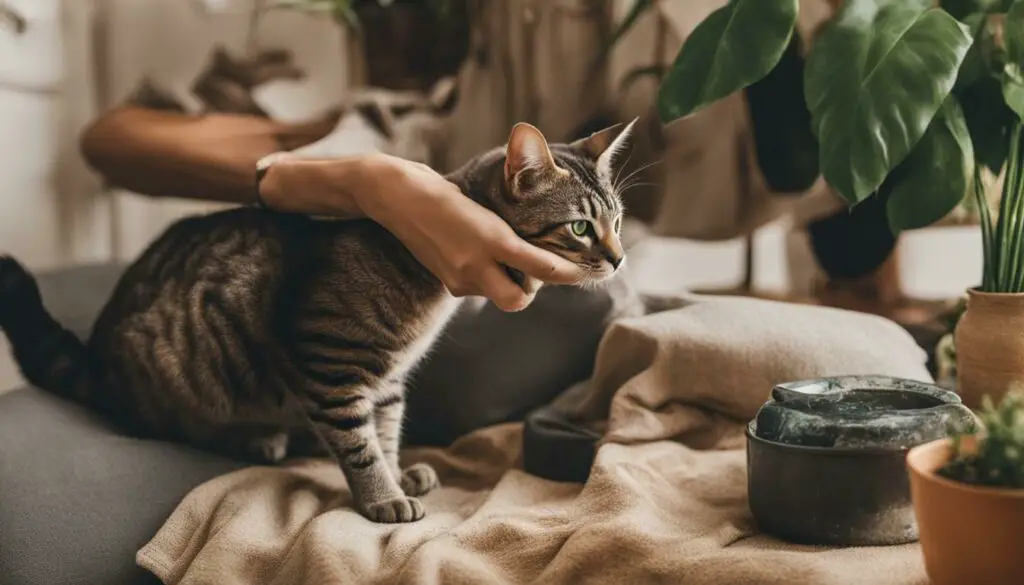
Conclusion
There are a few different ways to deal with a cat bite infection, but the most important thing is to be aware of the warning signs so that you can get treatment as soon as possible. The sooner you start treatment, the better your chances are of avoiding serious complications.
One of the most common complications of a cat bite infection is cellulitis, which is a bacterial infection of the skin and tissues underneath. Cellulitis can cause serious swelling, redness, and pain, and if it spreads to the lymph nodes it can be life-threatening.Another potential complication is sepsis, which is a systemic infection that can occur when bacteria from the bite gets into the bloodstream. Sepsis can cause organ failure and death, so it’s important to be aware of the warning signs and get treatment right away.
The best way to avoid these complications is to keep the wound clean and watch for any signs of infection. If you notice any redness, swelling, or pain, see your doctor right away. If you have any preexisting conditions that make you more susceptible to infection, such as diabetes, make sure to let your doctor know so they can keep an eye out for any early signs of trouble.
In most cases, a cat bite infection can be treated with antibiotics. However, in some cases surgery may be necessary to remove damaged tissue or drain an abscess. If you have a cat bite infection, it’s important to follow your doctor’s instructions and finish all of your antibiotics even if you start to feel better.
If you’re bitten by a cat, it’s important to clean the wound right away with soap and water. You should also see your doctor as soon as possible, even if the wound doesn’t seem serious. In some cases, a tetanus shot may be necessary. And if you have any signs of infection, it’s important to get treatment right away to avoid serious complications.
Understanding and addressing cat bites is essential for maintaining a safe and harmonious relationship with our feline friends. Cat bites can be concerning and potentially dangerous, as they can lead to infections. If you are bitten by a cat, it’s important to seek medical attention to prevent any complications.
There are various reasons why cats may bite, and it’s crucial to understand their behavior to address the issue effectively. Cats may bite as a way to communicate, signaling that they’ve had enough petting or play. Play aggression in kittens is common, but it should be redirected to appropriate toys to prevent them from biting human faces.
Fear or stress can also lead to cat bites, so creating a safe and calm environment for your cat is essential. Providing hiding spots, vertical spaces, and enriching activities can help reduce stress and promote a more relaxed atmosphere. It’s also important to rule out any underlying health problems that may cause aggression in cats.
Recognizing the warning signs of aggression in cats, such as changes in body language and vocalizations, can help prevent bites. By observing their behavior closely and responding appropriately, you can minimize the risk of cat bites. Remember, addressing cat bites requires understanding the reasons behind the behavior and taking appropriate measures to prevent and redirect aggression.
FAQ
Why do cats bite their owners’ faces?
Cats may bite their owners’ faces as a form of communication, such as to signal that they’ve had enough petting. It can also be due to play aggression in kittens or fear and stress in cats. It’s important to understand the reasons behind this behavior to address it appropriately.
Are cat bites dangerous?
Yes, cat bites can be dangerous as they can lead to infections. It’s important to seek medical attention if bitten to prevent complications. Proper first aid measures should be taken immediately after a cat bite, and any signs of infection should be evaluated by a healthcare professional.
How can I prevent cat bites?
Preventing cat bites involves creating a safe environment for your cat, understanding their body language and vocalizations to recognize aggression, and redirecting their behavior to appropriate toys and activities. Proper socialization, positive reinforcement, and seeking professional help when needed are also important in preventing cat bites.
What should I do if my cat bites me?
If your cat bites you, wash the wound with soap and water and apply an antiseptic. Monitor the bite for any signs of infection, such as redness, swelling, or pus. Seek medical attention if necessary. It’s important to avoid punishing your cat and instead focus on understanding the underlying cause of the bite and addressing it appropriately.
Can medical issues cause cat aggression?
Yes, certain medical issues can cause aggression in cats. It’s important to rule out any underlying health problems that may contribute to aggressive behavior. Consult with your veterinarian to evaluate your cat’s overall health and discuss any potential medical causes for aggression.
How can I recognize signs of aggression in my cat?
Recognizing the signs of aggression in cats involves understanding their body language, such as flattened ears, dilated pupils, and hissing or growling. Vocalizations and aggressive postures can also indicate aggression. Being attentive to these signs can help prevent attacks and respond appropriately.
What should I do during aggressive episodes?
During aggressive episodes, it’s important to give your cat space and time to calm down. Avoid punishment, as it can escalate the aggression. Use distraction techniques to redirect their attention to toys or treats. If the aggressive behavior persists or worsens, seek professional help from behaviorists or trainers.
How can I create a safe environment for my cat?
Creating a safe environment for your cat involves providing hiding spots, vertical spaces, and enriching activities. This helps reduce stress and promotes a calmer atmosphere. Proper socialization, positive reinforcement, and minimizing exposure to potential stressors are also important in creating a safe and secure environment.
How can I redirect my cat’s aggression?
Redirecting your cat’s aggression involves providing interactive toys and engaging in play sessions to channel their energy. Having scratching posts and other enrichment activities can also help satisfy their natural instincts. This helps redirect their aggression to more appropriate outlets.
When should I seek veterinary help for cat aggression?
If your cat’s aggression is frequent, intense, or poses a risk to your safety, it’s important to seek veterinary help. A veterinarian can evaluate your cat’s behavior, rule out any medical causes, and provide guidance on behavior modification techniques or medications if necessary.
How can I socialize my cat properly?
Proper socialization involves gradual introductions to new people and animals, focusing on positive experiences and rewards. Early socialization for kittens is crucial. Positive interactions, treats, and praise can help socialize your cat and minimize the risk of aggressive behavior.
What role does environmental enrichment play in preventing cat bites?
Environmental enrichment, such as providing toys, scratching posts, and interactive activities, helps keep cats mentally and physically stimulated. This reduces stress and promotes healthier behaviors, minimizing the likelihood of aggressive behavior and cat bites.
How can I implement positive reinforcement to prevent cat bites?
Implementing positive reinforcement involves rewarding desired behaviors and using treats or praise to reinforce positive interactions. Consistency and patience are important when using positive reinforcement to prevent cat bites. This helps create a positive and rewarding environment for your cat.
When should I seek professional help for cat aggression?
If you’re unable to address your cat’s aggression on your own or if the aggression is causing significant problems, it’s advisable to seek professional help from behaviorists or trainers. They can develop personalized behavior modification plans and provide guidance based on your cat’s specific needs.
How can I promote education and awareness about cat behavior and bite prevention?
Promoting education and awareness about cat behavior and bite prevention involves sharing knowledge through resources such as books, online articles, and local workshops. Engaging in discussions with fellow cat owners and participating in community events can also help spread awareness and prevent cat bites.
How can responsible ownership help prevent cat bites?
Responsible ownership plays a crucial role in preventing cat bites. Providing proper veterinary care, spaying/neutering, regular exercise, and mental stimulation help keep cats healthy and content. Teaching children how to interact with cats safely and respectfully is also important in preventing cat bites.

